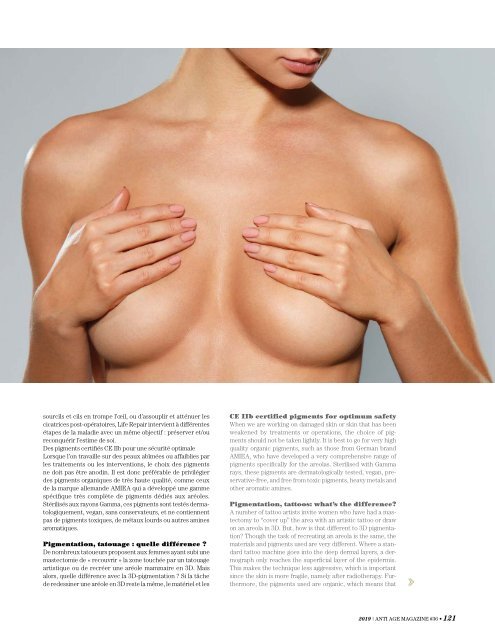ANTI-AGE #36
You also want an ePaper? Increase the reach of your titles
YUMPU automatically turns print PDFs into web optimized ePapers that Google loves.
sourcils et cils en trompe l’œil, ou d’assouplir et atténuer les<br />
cicatrices post-opératoires, Life Repair intervient à différentes<br />
étapes de la maladie avec un même objectif : préserver et/ou<br />
reconquérir l’estime de soi.<br />
Des pigments certifiés CE IIb pour une sécurité optimale<br />
Lorsque l’on travaille sur des peaux abîmées ou affaiblies par<br />
les traitements ou les interventions, le choix des pigments<br />
ne doit pas être anodin. Il est donc préférable de privilégier<br />
des pigments organiques de très haute qualité, comme ceux<br />
de la marque allemande AMIEA qui a développé une gamme<br />
spécifique très complète de pigments dédiés aux aréoles.<br />
Stérilisés aux rayons Gamma, ces pigments sont testés dermatologiquement,<br />
vegan, sans conservateurs, et ne contiennent<br />
pas de pigments toxiques, de métaux lourds ou autres amines<br />
aromatiques.<br />
Pigmentation, tatouage : quelle différence ?<br />
De nombreux tatoueurs proposent aux femmes ayant subi une<br />
mastectomie de « recouvrir » la zone touchée par un tatouage<br />
artistique ou de recréer une aréole mammaire en 3D. Mais<br />
alors, quelle différence avec la 3D-pigmentation ? Si la tâche<br />
de redessiner une aréole en 3D reste la même, le matériel et les<br />
CE IIb certified pigments for optimum safety<br />
When we are working on damaged skin or skin that has been<br />
weakened by treatments or operations, the choice of pigments<br />
should not be taken lightly. It is best to go for very high<br />
quality organic pigments, such as those from German brand<br />
AMIEA, who have developed a very comprehensive range of<br />
pigments specifically for the areolas. Sterilised with Gamma<br />
rays, these pigments are dermatologically tested, vegan, preservative-free,<br />
and free from toxic pigments, heavy metals and<br />
other aromatic amines.<br />
Pigmentation, tattoos: what’s the difference?<br />
A number of tattoo artists invite women who have had a mastectomy<br />
to “cover up” the area with an artistic tattoo or draw<br />
on an areola in 3D. But, how is that different to 3D pigmentation?<br />
Though the task of recreating an areola is the same, the<br />
materials and pigments used are very different. Where a standard<br />
tattoo machine goes into the deep dermal layers, a dermograph<br />
only reaches the superficial layer of the epidermis.<br />
This makes the technique less aggressive, which is important<br />
since the skin is more fragile, namely after radiotherapy. Furthermore,<br />
the pigments used are organic, which means that<br />
2019 | <strong>ANTI</strong> <strong>AGE</strong> MAGAZINE <strong>#36</strong> • 121

















